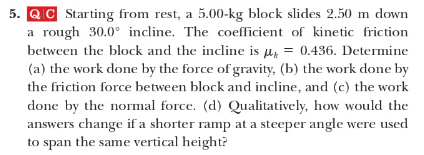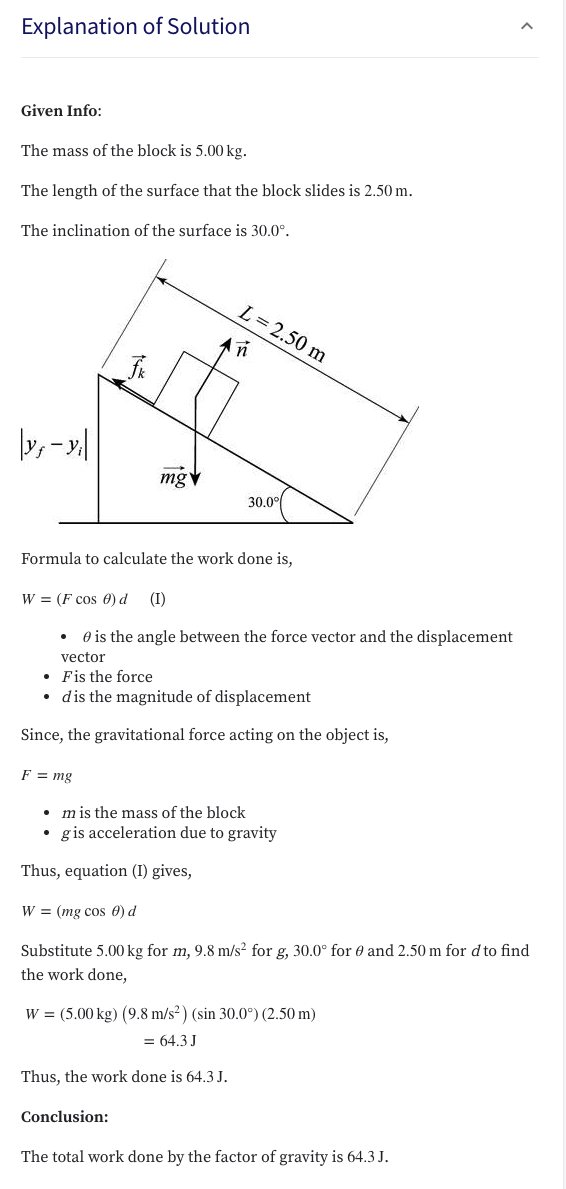5. QC Starting from rest, a 5.00-kg block slides 2.50 m down a rough 30.0° incline. The coefficient of kinetic friction between the block and the incline is ur = 0.436. Determine (a) the work done by the force of gravity, (b) the work done by the friction force between block and incline, and (c) the work done by the normal force. (d) Qualitatively, how would the answers change if a shorter ramp at a steeper angle were used to span the same vertical height? Explanation of Solution Given Info: The mass of the block is 5.00 kg. The length of the surface that the block slides is 2.50 m. The inclination of the surface is 30.0°. L= 2.50 m in »,-»| mgv 30.0° Formula to calculate the work done is, W = (F cos 0) d (I) O is the angle between the force vector and the displacement vector • Fis the force • dis the magnitude of displacement Since, the gravitational force acting on the object is, F = mg • m is the mass of the block • gis acceleration due to gravity Thus, equation (I) gives, W = (mg cos 0) d Substitute 5.00 kg for m, 9.8 m/s² for g, 30.0° for 0 and 2.50 m for d to find the work done, W = (5.00 kg) (9.8 m/s²) (sin 30.0°) (2.50 m) = 64.3 J Thus, the work done is 64.3 J. Conclusion: The total work done by the factor of gravity is 64.3 J.
5. QC Starting from rest, a 5.00-kg block slides 2.50 m down a rough 30.0° incline. The coefficient of kinetic friction between the block and the incline is ur = 0.436. Determine (a) the work done by the force of gravity, (b) the work done by the friction force between block and incline, and (c) the work done by the normal force. (d) Qualitatively, how would the answers change if a shorter ramp at a steeper angle were used to span the same vertical height? Explanation of Solution Given Info: The mass of the block is 5.00 kg. The length of the surface that the block slides is 2.50 m. The inclination of the surface is 30.0°. L= 2.50 m in »,-»| mgv 30.0° Formula to calculate the work done is, W = (F cos 0) d (I) O is the angle between the force vector and the displacement vector • Fis the force • dis the magnitude of displacement Since, the gravitational force acting on the object is, F = mg • m is the mass of the block • gis acceleration due to gravity Thus, equation (I) gives, W = (mg cos 0) d Substitute 5.00 kg for m, 9.8 m/s² for g, 30.0° for 0 and 2.50 m for d to find the work done, W = (5.00 kg) (9.8 m/s²) (sin 30.0°) (2.50 m) = 64.3 J Thus, the work done is 64.3 J. Conclusion: The total work done by the factor of gravity is 64.3 J.
College Physics
10th Edition
ISBN:9781285737027
Author:Raymond A. Serway, Chris Vuille
Publisher:Raymond A. Serway, Chris Vuille
Chapter5: Energy
Section: Chapter Questions
Problem 4P: a shopper in a supermarket pushes a cart with a force of 35 N directed at an angle of 25 below the...
Related questions
Question
100%
I am am doing problem 5. from Serway and Vuille - 11th edition. I dont understand why they use sin 30 and not cos 30 when the fomula for work = (F cos (theta)). d.
Is there away way you could draw a diagram to help explain it to me?
cheers.

Transcribed Image Text:5. QC Starting from rest, a 5.00-kg block slides 2.50 m down
a rough 30.0° incline. The coefficient of kinetic friction
between the block and the incline is ur = 0.436. Determine
(a) the work done by the force of gravity, (b) the work done by
the friction force between block and incline, and (c) the work
done by the normal force. (d) Qualitatively, how would the
answers change if a shorter ramp at a steeper angle were used
to span the same vertical height?

Transcribed Image Text:Explanation of Solution
Given Info:
The mass of the block is 5.00 kg.
The length of the surface that the block slides is 2.50 m.
The inclination of the surface is 30.0°.
L= 2.50 m
in
»,-»|
mgv
30.0°
Formula to calculate the work done is,
W = (F cos 0) d
(I)
O is the angle between the force vector and the displacement
vector
• Fis the force
• dis the magnitude of displacement
Since, the gravitational force acting on the object is,
F = mg
• m is the mass of the block
• gis acceleration due to gravity
Thus, equation (I) gives,
W = (mg cos 0) d
Substitute 5.00 kg for m, 9.8 m/s² for g, 30.0° for 0 and 2.50 m for d to find
the work done,
W = (5.00 kg) (9.8 m/s²) (sin 30.0°) (2.50 m)
= 64.3 J
Thus, the work done is 64.3 J.
Conclusion:
The total work done by the factor of gravity is 64.3 J.
Expert Solution
This question has been solved!
Explore an expertly crafted, step-by-step solution for a thorough understanding of key concepts.
This is a popular solution!
Trending now
This is a popular solution!
Step by step
Solved in 2 steps with 2 images

Knowledge Booster
Learn more about
Need a deep-dive on the concept behind this application? Look no further. Learn more about this topic, physics and related others by exploring similar questions and additional content below.Recommended textbooks for you

College Physics
Physics
ISBN:
9781285737027
Author:
Raymond A. Serway, Chris Vuille
Publisher:
Cengage Learning

College Physics
Physics
ISBN:
9781305952300
Author:
Raymond A. Serway, Chris Vuille
Publisher:
Cengage Learning

College Physics
Physics
ISBN:
9781938168000
Author:
Paul Peter Urone, Roger Hinrichs
Publisher:
OpenStax College

College Physics
Physics
ISBN:
9781285737027
Author:
Raymond A. Serway, Chris Vuille
Publisher:
Cengage Learning

College Physics
Physics
ISBN:
9781305952300
Author:
Raymond A. Serway, Chris Vuille
Publisher:
Cengage Learning

College Physics
Physics
ISBN:
9781938168000
Author:
Paul Peter Urone, Roger Hinrichs
Publisher:
OpenStax College

University Physics Volume 1
Physics
ISBN:
9781938168277
Author:
William Moebs, Samuel J. Ling, Jeff Sanny
Publisher:
OpenStax - Rice University

Principles of Physics: A Calculus-Based Text
Physics
ISBN:
9781133104261
Author:
Raymond A. Serway, John W. Jewett
Publisher:
Cengage Learning

Physics for Scientists and Engineers, Technology …
Physics
ISBN:
9781305116399
Author:
Raymond A. Serway, John W. Jewett
Publisher:
Cengage Learning